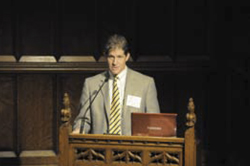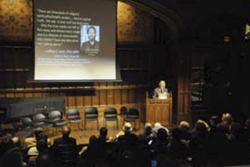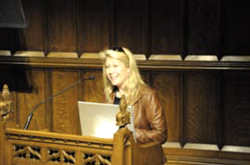Faith in Science
A TC conference explores the connections between the spiritual and the physical
By Suzanne Guillette
At a Hawaiian hospital in 2001, 11 self-described “healers” of varying backgrounds agreed to participate in a research study on distance healing, or the ability of prayer to affect physical well-being. Each healer chose a patient with whom he or she felt an emotional bond and who was also willing to undergo an MRI of the brain to measure neuronal activity. Physically separated from the patients, the healers were asked to perform prayers or meditations, depending on their respective backgrounds, in two-minute intervals. Although the patients had no knowledge of the timing of these prayers, the MRIs revealed that, for 10 of the 11 patients, there was a significant change in brain activity that correlated directly with the two-minute “on” intervals of the healers’ prayers.
The Hawaiian study, as it is called, was just one topic of discussion at “Spirituality and Healing: A Revolution of Consciousness,” a conference held in Milbank Chapel on November 19 and 20. Led by Lisa Miller, TC Associate Professor of Psychology and Education, the event brought together experts in the fields of medicine, engineering, psychology and spirituality, to discuss their work studying the effect of mental and spiritual activity on the body and the physical environment. The speakers were leading “post-material” scientists and healers who believe that consciousness can exist in states other than matter. All are also to contributors to Miller’s forthcoming edited volume, The Oxford University Press Handbook of Psychology and Spirituality.”
In his presentation at the conference, physician Larry Dossey, author of The Healing of Words, cited studies showing that those who follow a spiritual or religious path of some kind live on average seven to 13 years longer than those who do not, and have a lower incidence of all major diseases.
“When we talk about what it means to be a whole person, the West has generally thought of it as purely physical,” said Wayne Jonas, former Director of the Office of Alternative Medicine at the National Institutes of Health. “But this view is divergent from what the rest of the world has said throughout the millennia.”
Other speakers included Amit Goswami, quantum physicist and author of The Self-Aware Universe, Physics With a Soul, and Spiritual Activism; and Robert Jahn, Dean Emeritus of the School of Engineering and Applied Science at Princeton University and author, with Brenda Dunne, of Margins of Reality and Consciousness and the Source of Reality.
Every seat in Milbank was filled, with even the stairs serving as makeshift seats and people standing in the back.
“This is part of the education that our students seek,” said Miller, who is past president of the American Psychological Association Division of Psychology and Religion. “A new generation already lives according to post-materialist principles, and they are seeking knowledge from within this paradigm.”
“The event was exciting to me because it gave students an opportunity to see how powerful our spirits are in affecting change in the world,” said Lisa Noon, a first-year student in Columbia University’s Negotiation and Conflict Resolution Master’s Program. “In a place like Columbia where there is so much emphasis on the intellect, the power of the spirit is often ignored or disregarded.”
The conference concluded with the speakers resolving to create an Academy of Post-Materialist Science and Education, an organization intended to develop research-based curriculum and provide support for emerging education professionals in the field. Miller believes that schools should make the connection between science and spirituality a more explicit focus. She is seeking funding to build a college level course followed by a k-12 curriculum from a post-materialist perspective.
“There is a growing body of evidence that the spiritual does affect the physical, but unlike nations such as China, we aren’t teaching that to our students – and that puts them at a disadvantage,” Miller explains.
“TC has always been a place of transformative ideas,” she says. “A place of leading creative, radical thought that will serve our culture.”
Published Monday, Feb. 7, 2011


